If you are thinking or planning to build a house, you need to prepare many things. This will help you buy the materials and plan the place where it should be. Building your own house is a dream of possibly every person, and making it secure is the most critical concern one could have while building his or her own house, landscape, or fencing in cattle.
 Concrete bases are a vital resource in ensuring the strength of fence posts, that they will not blow away due to wind flow or get snatched or knocked by someone or an intruder. So technically, a person must know how many bags of Concrete they need for the fenConcrete
Concrete bases are a vital resource in ensuring the strength of fence posts, that they will not blow away due to wind flow or get snatched or knocked by someone or an intruder. So technically, a person must know how many bags of Concrete they need for the fenConcrete
Here are some of the little calculation margins for the fence and the Concrete.
If you don’t know how Concrete will be required for the concrete posts to stand firmly, you can calculate the figures by measuring them. Here is the formula.
First, you need to figure out how many concrete bags you will need for a single fence to multiply further.
How many bags of concrete per fence post?
You need two 50-pound bags of concrete per fence post that is 6-foot tall and 4×4 inches wide. To calculate the concrete volume that you need to use to build a fence post, you need to use the following formula:
Concrete volume [height of your fence post x 0.33-0.5 ft + width of your fence post x 3].
| Depth of hole in inches depth 1/2 to 1/3 high | Number of concrete bags for hole w/9 inch diameter 3'' post | Number of concrete bags for hole w/12 inch diameter 4'' post | Number of concrete bags for hole w/18 inch diameter 6'' post |
|---|---|---|---|
| 10 inches depth | 1 concrete bag | 2 concrete bags | 4 concrete bags |
| 12 inches depth | 1 concrete bags | 2 concrete bags | 4 concrete bags |
| 14 inches depth | 2 concrete bags | 2 concrete bags | 5 concrete bags |
| 16 inches depth | 2 concrete bags | 3 concrete bags | 5 concrete bags |
| 18 inches depth | 2 concrete bags | 3 concrete bags | 6 concrete bags |
| 20 inches depth | 2 concrete bags | 3 concrete bags | 6 concrete bags |
| 22 inches depth | 2 concrete bags | 3 concrete bags | 7 concrete bags |
| 24 inches depth | 2 concrete bags | 4 concrete bags | 7 concrete bags |
| 26 inches depth | 2 concrete bags | 4 concrete bags | 8 concrete bags |
| 28 inches depth | 3 concrete bags | 4 concrete bags | 9 concrete bags |
| 30 inches depth | 3 concrete bags | 4 concrete bags | 10 concrete bags |
| 32 inches depth | 3 concrete bags | 5 concrete bags | 10 concrete bags |
| 34 inches depth | 3 concrete bags | 5 concrete bags | 10 concrete bags |
| 36 inches depth | 3 concrete bags | 5 concrete bags | 11 concrete bags |
In simple words, this is how you can find out the number. Some might find the above-mentioned method a little bit difficult to comprehend. This formula below is a little easier to grasp and do some calculations.
This will give you the volume of your post hole, telling you exactly how many bags of Concrete you need. Most concreConcrete in bags weighing 10-80 pounds, but you can use the same 50-pound suitcase here.
Do not forget that before digging, you need to know the frost line for the fence post.
Why Concrete Is a Necessary part oConcreteucting fences?
Mixing Concrete and digging around the Concrete you are making may seem unnecessary, but they are essential. On the other hand, if you have a curvy sidewalk with multiple patterns or borders, expect to pay more than those with simple, plain, straight, grey sidewalks.
Concrete makes the surface firm, so mixing it in the material for the fence posts is the most beneficial since it can help you make your fences strong enough to bear a strong and heavy wind flow. Concrete remains durable and long-lasting if you add it to the material. Concrete is a case of fences made without Concrete in their bases. The wiConcreteaffect those fences’ durability and quickly loses them from their bases and falls off without extra effort. Furthermore, Concrete used in the sidewalksConcreteome a trend and a is part of the long way.
Concrete is also important in sidewalk construction since it can make the sidewalks more stable and withstand weight and weather conditions. Concrete is now an essential ingredient for constructive use. It can also withstand the strength of wind storms and thunderstorms.




